Rivera Sun's Blog: From the Desk of Rivera Sun, page 28
May 27, 2016
Living Life Unusual

This quote is from Steam Drills, Treadmills, and Shooting Stars, a novel about coal and climate change. Photo by Forrest Cook.
The crises of our current human predicament offer us the thin silver lining of opportunity . . . we can – and must – live life differently, defying old beliefs, redefining what it means to live a fulfilling and meaningful life. We are being called to question everything. The entire structure of society, civilization, economy, politics, arts, culture are all on the table, open to discussion, and reconfiguration.
I find this invigorating. “Success”, in the old definitions, is increasingly becoming unattainable and thus irrelevant. For me, friendships, creativity, self-education and learning, connection to the Earth, listening, expressing, healing, waging peace, working for social change and justice are all rising in importance in my worldview.
I want to know my local bakers, see where the lettuce and kale are growing, heal my body with herbal remedies, use radio, writing, social media, and home-made videos for expressing deep thoughts and bold ideas. These are the ways in which I’m moving toward a new culture of respect, dignity, human creativity, love of our communities, the land, each other. I, like so many others, am integrating an understanding of living systems theory into my everyday life, and allowing this way of being to influence how I work in groups, communicate, show up in movements, participate in projects and endeavors.
It’s a powerful world. I invite you to join me in building this in your own way, in your own life, in your own community. Here’s to living life unusual!
____________________________
A uthor/Activist Rivera Sun, syndicated by PeaceVoice, is the author of The Dandelion Insurrection, Billionaire Buddha and Steam Drills, Treadmills, and Shooting Stars, the cohost of Love (and Revolution) Radio, and the cofounder of the Love-In-Action Network. She is a trainer and social media coordinator for Campaign Nonviolence and Pace e Bene. Sun attended the James Lawson Institute on Strategic Nonviolent Resistance in 2014 and her essays on social justice movements appear in Truthout and Popular Resistance. www.riverasun.com
uthor/Activist Rivera Sun, syndicated by PeaceVoice, is the author of The Dandelion Insurrection, Billionaire Buddha and Steam Drills, Treadmills, and Shooting Stars, the cohost of Love (and Revolution) Radio, and the cofounder of the Love-In-Action Network. She is a trainer and social media coordinator for Campaign Nonviolence and Pace e Bene. Sun attended the James Lawson Institute on Strategic Nonviolent Resistance in 2014 and her essays on social justice movements appear in Truthout and Popular Resistance. www.riverasun.com
Salt Thoughts . . .
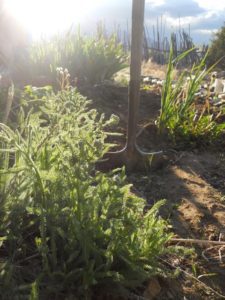 Whenever someone asks me, “What is our salt? What is the US equivalent of Gandhi’s constructive program?” I tell them that I think it’s local food and gardening, seed saving, and caring for the Earth. Whether we’re planting in pots or urban community gardens, or we’re on a small farm, or, like me, you lovingly tend your tiny garden, I think these acts of growing change are our constructive program for much of what ails the US.
Whenever someone asks me, “What is our salt? What is the US equivalent of Gandhi’s constructive program?” I tell them that I think it’s local food and gardening, seed saving, and caring for the Earth. Whether we’re planting in pots or urban community gardens, or we’re on a small farm, or, like me, you lovingly tend your tiny garden, I think these acts of growing change are our constructive program for much of what ails the US.
We have many potentialities for a project that strengthens our movements, lessens our dependency on our oppressors, builds self-reliance, and is a tangible activity that almost everyone can do. Here’s a few more ideas (and add your own in the comments):
Entertainment and Media: Go nonviolent on this, turn off the corporate media, liberate your mind, and watch a documentary, read a social protest novel (I recommend The Dandelion Insurrection), create your own art or music, go see a local band. There are many ways to evict corporations and oligarchs from our minds, hearts, and souls … taking back our entertainment and media through consciously creating and participating in healthy, respectful, nonviolent alternatives is one of them.
Restorative Justice: In a nation that has the largest prison population in the history of the world, ending punitive justice and shifting to restorative justice is a watershed concept. It can be brought to schools, workplaces, and our justice system. And yes, you could be the person to bring it to your community. Gandhi, btw, had bunches of constructive programs, one of which was local arbitration courts. He encouraged Indian lawyers to refuse to work in the British courts, and instead mediate disputes in the villages.
Giving and Sharing Economy: Tool coops, little free libraries, seed exchanges, toy libraries, barter networks, commons systems . . . there’s more than one way to do business, and the more we can move our exchanges out of the monetized corporate-capitalist system, the better it will be for our friends, families, and communities.
This is a “shortlist”. Add your own ideas to this list, and better yet, put them into action in your community.
____________________________
A uthor/Activist Rivera Sun, syndicated by PeaceVoice, is the author of The Dandelion Insurrection, Billionaire Buddha and Steam Drills, Treadmills, and Shooting Stars, the cohost of Love (and Revolution) Radio, and the cofounder of the Love-In-Action Network. She is a trainer and social media coordinator for Campaign Nonviolence and Pace e Bene. Sun attended the James Lawson Institute on Strategic Nonviolent Resistance in 2014 and her essays on social justice movements appear in Truthout and Popular Resistance. www.riverasun.com
uthor/Activist Rivera Sun, syndicated by PeaceVoice, is the author of The Dandelion Insurrection, Billionaire Buddha and Steam Drills, Treadmills, and Shooting Stars, the cohost of Love (and Revolution) Radio, and the cofounder of the Love-In-Action Network. She is a trainer and social media coordinator for Campaign Nonviolence and Pace e Bene. Sun attended the James Lawson Institute on Strategic Nonviolent Resistance in 2014 and her essays on social justice movements appear in Truthout and Popular Resistance. www.riverasun.com
From One Human Heart To Another . . .
 To everyone who is heartbroken, tired, sick, worried: you’re not crazy. You’re persevering remarkably. The systems of our juggernaut world are cruel, crushing, and insane. You’ve been strong. You’ve been courageous, whether you’ve been protesting on the front lines or managing to stay alive one more day through intense pain.
To everyone who is heartbroken, tired, sick, worried: you’re not crazy. You’re persevering remarkably. The systems of our juggernaut world are cruel, crushing, and insane. You’ve been strong. You’ve been courageous, whether you’ve been protesting on the front lines or managing to stay alive one more day through intense pain.
And you’re loved.
From one human heart to another . . . you are loved. I know this world can hurt. We, as humans, were not made to live like this. We were designed by laughter, love, connection, collaboration, cooperation, caring, nurturing. We were crafted by creativity, ingenuity, and healing. We are hardwired for empathy and compassion. We were born with our human hearts falling in love with this amazing world. And we are here to “awaken from the delusion of our separateness” to quote Thich Nhat Hanh.
Our systems need unraveling and rapid transformation. It’s big and scary . . . but you know what’s more frightening? Continuing the way we’re going: hurting one another, waging war, accepting poverty, tolerating racism, mistreating women and children, letting our fellow citizens writhe in pain unable to access healthcare, shaming and shunning our neighbors without homes, destroying our beloved planet, and living in fear and distrust of one another.
We can do better than this. And, by all that’s holy – and the strength and perseverance shown by each person alive today – I know we can do it. Through daily actions, nonviolent movements for change, determined community building, participation in new systems, and ferocious, beautiful love, I know we can transform our world. I’m already seeing it happen.
The quote on this image is from my novel, The Dandelion Insurrection. You can find it here.
____________________________
A uthor/Activist Rivera Sun, syndicated by PeaceVoice, is the author of The Dandelion Insurrection, Billionaire Buddha and Steam Drills, Treadmills, and Shooting Stars, the cohost of Love (and Revolution) Radio, and the cofounder of the Love-In-Action Network. She is a trainer and social media coordinator for Campaign Nonviolence and Pace e Bene. Sun attended the James Lawson Institute on Strategic Nonviolent Resistance in 2014 and her essays on social justice movements appear in Truthout and Popular Resistance. www.riverasun.com
uthor/Activist Rivera Sun, syndicated by PeaceVoice, is the author of The Dandelion Insurrection, Billionaire Buddha and Steam Drills, Treadmills, and Shooting Stars, the cohost of Love (and Revolution) Radio, and the cofounder of the Love-In-Action Network. She is a trainer and social media coordinator for Campaign Nonviolence and Pace e Bene. Sun attended the James Lawson Institute on Strategic Nonviolent Resistance in 2014 and her essays on social justice movements appear in Truthout and Popular Resistance. www.riverasun.com
Teach-Ins and Nonviolent Movements
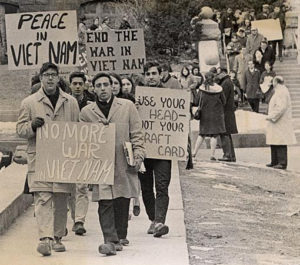
Antiwar protesters in January 1965, uwdigitalcollections – Student protesters marching down Langdon Street, CC BY 2.0
This week in nonviolent history, we celebrate the effective and versatile tactic of the teach-in. One of the largest teach-ins during the Vietnam War, for example, was held on May 21st-23rd, 1965 at UC Berkeley with 10-30,000 students attending. The State Department was invited to send a representative, but declined. An empty chair was set on the stage during the teach-in with a sign that read “Reserved for the State Department” taped to the back.
“A teach-in is similar to a general educational forum on any complicated issue, usually an issue involving current political affairs. The main difference between a teach-in and a seminar is the refusal to limit the discussion to a specific frame of time or a strict academic scope. Teach-ins are meant to be practical, participatory, and oriented toward action. While they include experts lecturing on the area of their expertise, discussion and questions from the audience are welcome.”
– Wikipedia
As a nonviolent action, a teach-in is often offered in the context of protest or resistance. The first teach-in, for example, was held at the University of Michigan in 1965 to protest the Vietnam War, and was organized as an alternative to the previously planned teachers’ strike. Instead of going on strike, the professors held a teach-in, showing up at the university, but teaching about the Vietnam War instead of their regular curriculum.
Teach-ins are a powerful method of nonviolent action that have been used in a wide variety of situations. In the United States in the 1990s, a new series of teach-ins focused on the corporatization of education and on corporate power generally, called the Democracy Teach-Ins, paved the way for the massive demonstrations, including the 1999 Seattle WTO protests; and the 2003 national Books Not Bombs student strike. In 2011, Occupy Wall St. used teach-ins to inform, educate, and mobilize the massive protests against the 1%, bank bailouts, and wealth inequality.
The year, Campaign Nonviolence is inviting teachers, peace educators, nonviolence trainers, and activists to offer teach-ins during the Campaign Nonviolence Week of Actions September 18-25th, 2016.
Imagine . . . where could you offer a teach-in? How about a de-escalation training with your local police department? Or perhaps a teach-in on climate change at your city council meeting? What if you offered a teach-in on living wages to your local business associations? Maybe you could offer nonviolent communication training for the youth groups in your area . . . the possibilities are endless, and they all help to bring the skills and knowledge of a culture of active nonviolence into our communities.
Join the growing movement for a culture of active nonviolence by organizing a teach-in in your area or online during the Week of Actions September 18-25th.
Learn more about the history on Wikipedia:
https://en.wikipedia.org/wiki/Teach-in
Author/Activist Rivera Sun, syndicated by PeaceVoice, is the author of The Dandelion Insurrection and other books, and the Programs Coordinator for Campaign Nonviolence.
May 14, 2016
Remembering Nonviolent History: Blue Revolution – Kuwaiti Women Gain Suffrage
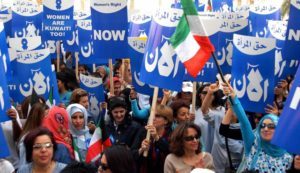
KUWAIT CITY, KUWAIT: Kuwaiti women demonstrate in front of the parliament building in Kuwait City to demand their political rights, 07 March 2005. As a battle has raged in the Gulf emirate over political rights for its disenfranchised women, female activists and their liberal supporters staged the rally the morning the parliament was scheduled to discuss a government request to speed up the debate on a women’s rights bill. The bill, approved by the cabinet last May and opposed by Islamic hardliners, calls for amending article one of the 1962 electoral law which limits voting and candidacy to male citizens whereas the constitution stipulates gender equality. AFP PHOTO/YASSER AL-ZAYYAT (Photo credit should read YASSER AL-ZAYYAT/AFP/Getty Images)
This week in nonviolent history commemorates the successful conclusion of Kuwait’s Blue Revolution. On May 17th, 2005, Kuwaiti women gained suffrage after more than 40 years of struggle. The women used a wide variety of approaches to achieve their goals, including lobbying, introducing repeated legislation, protests and demonstration, marches, rallies, and mock elections.
Like many women’s suffrage movements around the world, the Kuwaiti women escalated their actions and campaigns, shifting from legislative and legal efforts into nonviolent direct action. The history of their multi-decade effort is complex, spanning from the 1960s when Kuwait won independence from the United Kingdom, through the Iraqi occupation in 1990-1991, and onward another 15 years until a series of nonviolent actions, changing political climate, and increased pressure finally won the vote for the women of Kuwait.
The movement first began to apply bolder methods of nonviolent action in 1996 when 500 women stopped working for an hour to demand suffrage. Then, as the Global Nonviolent Action Database reports, “In 2002, several women held a demonstration near two voter registration centers in Kuwait. The demonstrators waved banners outside the two centers, but were eventually asked to leave. Kuwaiti women continued to be very assertive in 2003. There were reports of demonstrations involving more than 1,000 women in a country with a total population of two million. The campaign also unsuccessfully sued both the Minister of the Interior and the Speaker of Parliament. During the elections of 2003, women established mock ballots that allowed hundreds of women to cast symbolic votes for real candidates.”
In March of 2005, after highly visible and captivating actions, 1,000 demonstrators gathered outside of the Kuwaiti parliament to continue their demand for basic voting rights. Many women wore pale blue to represent the struggle for suffrage, leading to the moniker, “The Blue Revolution.” On May 17th, Kuwaiti parliament passed the long-awaited suffrage bill, granting women the right to vote and run for elected office.
The Blue Revolution is part of the Color Revolutions, a series of nonviolent movements that erupted from the 1970s to present day, with a peak in the late 90s and early 2000s. These movements include, the Carnation Revolution in Portugal, the People Power Revolution (also known as the Yellow Revolution) in the Philippines, the Velvet Revolution in Czechoslovakia, the Rose Revolution in Georgia, the Orange Revolution in the Ukraine, the Cedar Revolution in Lebanon, the Denim Revolution in Belarus, the Green Revolution in Iran, among many others. The use of identifiable colors and symbols was often used as an intentional tactic of solidarity and visible protest.
____________________________
A uthor/Activist Rivera Sun, syndicated by PeaceVoice, is the author of The Dandelion Insurrection, Billionaire Buddha and Steam Drills, Treadmills, and Shooting Stars, the cohost of Love (and Revolution) Radio, and the cofounder of the Love-In-Action Network. She is a trainer and social media coordinator for Campaign Nonviolence and Pace e Bene. Sun attended the James Lawson Institute on Strategic Nonviolent Resistance in 2014 and her essays on social justice movements appear in Truthout and Popular Resistance. www.riverasun.com
uthor/Activist Rivera Sun, syndicated by PeaceVoice, is the author of The Dandelion Insurrection, Billionaire Buddha and Steam Drills, Treadmills, and Shooting Stars, the cohost of Love (and Revolution) Radio, and the cofounder of the Love-In-Action Network. She is a trainer and social media coordinator for Campaign Nonviolence and Pace e Bene. Sun attended the James Lawson Institute on Strategic Nonviolent Resistance in 2014 and her essays on social justice movements appear in Truthout and Popular Resistance. www.riverasun.com
May 10, 2016
Yes to Assertive, No to Aggressive by Tom Hastings
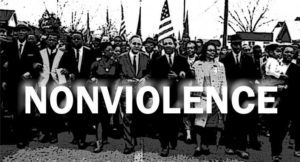
“Nonviolence” by Democracy Chronicles. CC 2.0 See the article “Martin Luther King Jr’s Nonviolent Strategy” for the original image.
I teach and write in the field of Peace and Conflict Studies, with a special focus on strategic nonviolence. It is a rich field, growing in its scholarship and its widespread usage. I’m so enthused by this—the more we wage our conflicts with nonviolence the lower the costs.
Counting the costs of conflict, we normally think of blood and treasure, of casualties and expense. We are slowly beginning to also count other costs, including our environment, our relationships, our civil rights, our human rights, our metrics of democracy, and more. Nonviolence is superior to violence in every way if we read the research and consider all the costs.
Nonviolence can fail, of course, and in the most robust of struggles—trying to overthrow a dictator, for example—nonviolent struggle only works about 53 percent of the time. Of course violent insurgency only succeeds 26 percent of the time, about half as often as does nonviolence. This is disturbing to those who define revolution as violent. I hope they get over it. Wake up and smell the flowers instead of the cordite…
One secret to nonviolent success is communication. When we are quiet the injustices we see or suffer are allowed to continue. When we are aggressive—either violent or demeaning, threatening, and insulting—that strengthens the resolve of the opponent and progress is unlikely. The best path to victory is assertion—visualize a thin bright line between you and the oppressor. Shrink back from the line and nothing changes. Charge over the line and all defenses spring into counter-aggression, counterattack. But go up to the line with insistent civil assertion, creative and resilient, and your chances for winning your objectives are radically increased.
These principles are basic, but ignored all too often, as we see in many conflicts domestic and transnational, in families and workplaces, in neighborhoods and in towns, in regions and states. The destructive, adversarial conflicts that result are often heartbreaking to observe. From a belligerent North Korean dictator to a misogynist Donald Trump, the results are not impressive. Ruling over others is a poor path to sustainable gains and doing so in an aggressive manner will only generate pushback. If that resistance is civil but insistent, assertive but not aggressive, it can achieve what no one thought possible.
If I had predicted publicly in 1985 that the Philippines would see Marcos deposed without a single fired shot, that the Berlin Wall would fall in a massive nonviolent uprising, that Nelson Mandela would be liberated and apartheid would end without a widely predicted bloodbath, that Pinochet would fall in Chile to mass nonviolent power, and that Slobodan Milosevic would create horrific wars in the Balkans but would be deposed by nonviolence, I might have been diagnosed as delusional.
These cases and 1,000 more are chronicled in a Swarthmore database that is growing constantly. We are humans—we have great big brains that are hard-wired for all possible responses, from violent to nonviolent, which makes us the unique species neurologically capable of infinite, illimitable choice. Let’s be wise about it.
_____________
Dr. Tom H. Hastings is Founding Director of PeaceVoice .
May 8, 2016
Remembering Nonviolent History: Freedom Rides
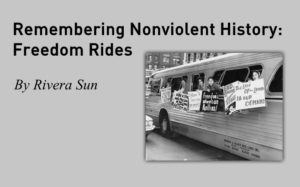 By May 1961, federal law had already ruled that segregation on interstate, public buses was illegal. Southern states, however, maintained segregation in seating, and at bus station bathrooms, waiting rooms and drinking fountains. The Interstate Commerce Commission refused to take action to enforce federal law. To change this, the Civil Rights Movement (CORE, SNCC, NAACP) began a series of Freedom Rides on May 4th, 1961, 55 years ago. By the end of the campaign, 436 individuals had participated in at least 60 separate Freedom Rides, ultimately forcing the Interstate Commerce Commission to enforce federal law and desegregate interstate bus services.
By May 1961, federal law had already ruled that segregation on interstate, public buses was illegal. Southern states, however, maintained segregation in seating, and at bus station bathrooms, waiting rooms and drinking fountains. The Interstate Commerce Commission refused to take action to enforce federal law. To change this, the Civil Rights Movement (CORE, SNCC, NAACP) began a series of Freedom Rides on May 4th, 1961, 55 years ago. By the end of the campaign, 436 individuals had participated in at least 60 separate Freedom Rides, ultimately forcing the Interstate Commerce Commission to enforce federal law and desegregate interstate bus services.
The Freedom Riders drew inspiration from the Journey of Reconciliation in 1947, led by Bayard Rustin and George Houser. The Freedom Rides campaigns followed on the heels of the highly visible lunch counter sit-in campaigns that began in 1960. Diane Nash, a veteran of the Nashville, Tennessee, campaign, was one of the lead organizers of the Freedom Rides, and it was at her urging that the demonstrators persevered through the extreme violence, carrying on to success despite life-threatening situations.
The Freedom Riders’ nonviolent strategy led to careful and effective tactics, placing themselves symbolically in challenging places—black riders sitting up front, white and black sitting together—but with one rider observing Southern segregation customs in order to avoid arrest and contact CORE to arrange bail for those jailed.
Strategy, training, and discipline were essential components of preparation for the Freedom Riders. Over the four months of the campaign, they were beaten, arrested, attacked by mobs; the buses were set on fire, the KKK surrounded them and threw tear gas into the locked buses; at times, Greyhound and Trailways bus lines refused to protect or transport them; hospitals denied care and ambulances would not carry injured Freedom Riders. All Freedom Riders practiced flawless nonviolent discipline despite massive provocation.
On May 14, Mother’s Day, in Anniston, Alabama, Ku Klux Klansmen, some still in church attire, attacked the first of two buses arriving and departing from the station. The driver tried pull away, but was blocked by KKK members. The tires were slashed. A few miles outside of town, the crippled bus was forced to stop by the KKK, who firebombed it. The mob held the doors shut, intending to burn the riders to death. The riders escaped the bus, but were then severely beaten. Only warning shots fired into the air by highway patrolmen prevented the riders from being lynched. The second of the two buses arriving in Anniston, Alabama, likewise faced violent attacks, leaving Freedom Riders semi-conscious in the back of the bus.
Throughout the summer, the Freedom Riders persevered, facing violence, intimidation, and arrests. The nation was shocked by both the violence and the knowledge that southern authorities were ignoring federal laws—the fearless nonviolence of the Freedom Riders gained sympathy and respect. The Freedom Riders escalated until September, when the ICC, faced with the likelihood of more nonviolent direct action campaigns, issued new policies enforcing the desegregation of interstate buses. On November 1, 1961, when the new ICC rules took effect, passengers were permitted to sit wherever they pleased on interstate buses and trains; “white” and “colored” signs were removed from the terminals; racially segregated drinking fountains, toilets, and waiting rooms serving interstate customers were desegregated; and the lunch counters began serving all customers, regardless of race.
The Freedom Rides are a powerful example of the use of nonviolent direct action to enforce justice and fair laws. Remember, by 1961, federal law forbid segregation on interstate buses. Using nonviolent action, the Freedom Riders exercised their rights, upheld the law, and refused to cooperate with injustice.
A uthor/Activist Rivera Sun, syndicated by PeaceVoice, is the author of The Dandelion Insurrection, Billionaire Buddha and Steam Drills, Treadmills, and Shooting Stars, the cohost of Love (and Revolution) Radio, and the cofounder of the Love-In-Action Network. She is a trainer and social media coordinator for Campaign Nonviolence and Pace e Bene. Sun attended the James Lawson Institute on Strategic Nonviolent Resistance in 2014 and her essays on social justice movements appear in Truthout and Popular Resistance. www.riverasun.com
uthor/Activist Rivera Sun, syndicated by PeaceVoice, is the author of The Dandelion Insurrection, Billionaire Buddha and Steam Drills, Treadmills, and Shooting Stars, the cohost of Love (and Revolution) Radio, and the cofounder of the Love-In-Action Network. She is a trainer and social media coordinator for Campaign Nonviolence and Pace e Bene. Sun attended the James Lawson Institute on Strategic Nonviolent Resistance in 2014 and her essays on social justice movements appear in Truthout and Popular Resistance. www.riverasun.com
Mother’s Day Poems
 Happy Mother’s Day to my incredible, artistic, courageous, wonderful mother, Kate Simonds!
Happy Mother’s Day to my incredible, artistic, courageous, wonderful mother, Kate Simonds!
Bouquets of Mother
by Rivera Sun
My mother,
Kathryn,
a name standing
tall on two feet
strong like the black coffee
she drank.
My mother
drove tractors
and wrangled
five children
through chores
last minute homework
breakfast cereal
dish duty
and onto the school bus
before the sun split
a crack in the sky.
My mother
cut armloads of bouquets
from the immense
bursting forth of the yard
day lilies, bold orange
Queen Anne’s Lace, ocean spray white
irises, lavender
royal tongues of vetch
humble buttercups
primroses walloping the house
with perfume.
My mother
stretched into a tree
with her length of limbs, reaching
for the top shelf of vases,
lined up sensuous, round
glass women curved with grace.
My mother
must have heard
turn-of-the-century
ghost voices of women
on strike from factories
and endless days of labor,
singing for bread
for their children
and roses
for their souls.
My mother
knew working
from dawn long into the dark,
moving from housework
to fieldwork to homework
to exhaustion
and on the table
like a promise
stood the armloads
of flowers
held in the curved arms
of a vase.
From Skylandia Farm Poetry by Rivera Sun http://www.riverasun.com/skylandia/
 My mother, Kate Simonds, is an incredible, creative human being. She raised five kids (two sets of twins and a sister in between), ran a farm, engaged with our education in a homeschooling, hands-on way, went with me to Europe in high school, arranged for my fifteen year old self to become a spinning and weaving apprentice, bailed me out of trouble once when I was stuck on an island with nothing but $50 bucks and a bunch of missed plane connections. She has nurtured my creativity, challenged by half-hearted efforts into full-blown inspiration, and supported me in countless ways. Here’s a poem a wrote about libraries, and my amazing mother. I wrote it in Chicago at a public library, remember all of our trips to the library when I was a child. It is featured in Skylandia: Farm Poetry: http://www.riverasun.com/skylandia/
My mother, Kate Simonds, is an incredible, creative human being. She raised five kids (two sets of twins and a sister in between), ran a farm, engaged with our education in a homeschooling, hands-on way, went with me to Europe in high school, arranged for my fifteen year old self to become a spinning and weaving apprentice, bailed me out of trouble once when I was stuck on an island with nothing but $50 bucks and a bunch of missed plane connections. She has nurtured my creativity, challenged by half-hearted efforts into full-blown inspiration, and supported me in countless ways. Here’s a poem a wrote about libraries, and my amazing mother. I wrote it in Chicago at a public library, remember all of our trips to the library when I was a child. It is featured in Skylandia: Farm Poetry: http://www.riverasun.com/skylandia/
Library Books
by Rivera Sun
At the Lincoln Street Library
in the city of Chicago
a last remaining outpost of public space
where citizens can rest
and children come with parents
where a man finishes
a course of study
on his lunch break
his orange tape measure
pulled from his belt
placed on the table
alongside stacks of papers
and an army fatigue backpack.
I, itinerate writer,
hiding
from the battering
cold Chicago concrete
and clattering L train thunder
remembering the days
when my four scrawny siblings
poor rural white children
growing up in a rundown mill town
were hauled by my six foot tall mother
once a week
down the steep
Court Street hill
and back up
as she lugged
two canvas tote bags
loaded with books
four per child
twenty volumes or more.
My mother was strong
with determination
even on the uphill climb
to putting food on the table
and shoes on our feet.
I remember, one night,
nine o’clock
watching public television
when she won forty bucks
in the Maine State Lottery
and cried . . .
because only that miracle
put gloves on our fingers
that frostbitten year.
In the lean times,
there were no pizza nights
only endless variations on spaghetti
and occasionally
the cupboards reached
the stage of empty
only miracles can solve.
There were no treats
that cost cash
but every week
new books
were hauled up the hill
from the Auburn Public Library
containing exotic places
other worlds
beyond the endless
aching stretch
of making ends meet.
I think on those times
sitting in the Lincoln Street Library
a thousand miles
and twenty years
past the days
of a six foot tall mother’s
struggle to get me
through a long string
of miracles
to today.
Find this poem and others from my days growing up on an organic farm in Northern Maine.
A uthor/Activist Rivera Sun, syndicated by PeaceVoice, is the author of The Dandelion Insurrection, Billionaire Buddha and Steam Drills, Treadmills, and Shooting Stars, the cohost of Love (and Revolution) Radio, and the cofounder of the Love-In-Action Network. She is a trainer and social media coordinator for Campaign Nonviolence and Pace e Bene. Sun attended the James Lawson Institute on Strategic Nonviolent Resistance in 2014 and her essays on social justice movements appear in Truthout and Popular Resistance. www.riverasun.com
uthor/Activist Rivera Sun, syndicated by PeaceVoice, is the author of The Dandelion Insurrection, Billionaire Buddha and Steam Drills, Treadmills, and Shooting Stars, the cohost of Love (and Revolution) Radio, and the cofounder of the Love-In-Action Network. She is a trainer and social media coordinator for Campaign Nonviolence and Pace e Bene. Sun attended the James Lawson Institute on Strategic Nonviolent Resistance in 2014 and her essays on social justice movements appear in Truthout and Popular Resistance. www.riverasun.com
May 5, 2016
“Midwife to Change” from The Dandelion Insurrection
 This is an excerpt from Rivera Sun’s novel, The Dandelion Insurrection, featuring a moment when Zadie Byrd Gray commits to being a love-motivated changemaker and living up to her inner potential. Find the whole novel here.
This is an excerpt from Rivera Sun’s novel, The Dandelion Insurrection, featuring a moment when Zadie Byrd Gray commits to being a love-motivated changemaker and living up to her inner potential. Find the whole novel here.
“There are three hundred million people in this country and someone has to pull their love from the womb of their hearts and spur them into action,” Zadie said.
He froze in the moonlight, looking younger than the night. She stilled beside him, seeming more ancient than the stars. Their feet sank into the fertile soil of the heartland. The country spread out around them in a compass rose. North, south, east, and west, change pulsed against the surface of reality. A new world was waiting to be born. Charlie saw it reflected in Zadie’s determined eyes. She peered into the void and saw kindness and compassion, connection and caring. Her long fingers slid across each other, ready to reach into the womb and pull out the future.
“I’m going to midwife this coming world,” she told him, certain.
He said nothing at first. Shivers ran up and down his spine, tingling across his scalp. He licked his lips. They split. He tasted blood.
“How?” he asked her.
“I have to find the mothers of the nation,” she said. “They’re out there. I have to pull their love from inside them and send it howling out into life. Then I have to find the fathers and hand them this newborn compassion. I have to lay it in their arms, tender and fragile, and let them love it like a child. Then I have to find the teachers, the aunties, the grandparents, the cousins . . .”
As she spoke, the vision gleamed in her eyes. Charlie caught himself glancing out into the night, hoping to see what she saw, but finding only the stark silver lines of the fields, the black river of road, and the whispering grasses that swept up to his feet.
“Do you have to go?” he asked. “Can’t you just track them down online – ”
“You can’t deliver a baby online,” she said, laughing at the notion. “What if it’s coming out the wrong way? What if the mother is too narrow or scared? Or all alone in the middle of nowhere, frightened? You’ve got to be there with them, Charlie.”
Charlie heard the conviction in her voice. She looked so ancient, this young midwife of the world, peering into mysteries that no one else could see. It was a Zadie he had never seen before, and yet had been there all along.
______________
An excerpt from Rivera Sun’s novel, The Dandelion Insurrection. Find reviews and copies here. You may also enjoy this excerpt from the novel: http://www.riverasun.com/midwife-to-the-coming-world-an-excerpt-from-the-dandelion-insurrection/
May 1, 2016
Mother Jones and May Day
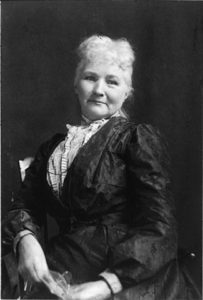
Mother Jones, American labor activist, by Bertha Howell, Public Domain
“In all my career I have never advocated violence. I want to give the nation a more highly developed citizenship.” – Mother Jones
This week commemorates the anniversary of the Haymarket Affair, International Workers’ Day, and the claimed birthday of Mother Mary Harris Jones. While the United States’ official Labor Day falls in September, the international community celebrates workers and workers rights on May 1st, in recognition of actions taken by Americans in 1886, and the events that led up to the Haymarket Massacre.
On May 1, 1886, more than 300,000 workers in 13,000 businesses across the United States walked off their jobs in the first May Day celebration in history. In Chicago, the epicenter for the 8-hour workday organizers, 40,000 went out on strike. The strike continued for three days, and, though violence broke out between strikers and police in one location, the bulk of the strikers remained nonviolent.
On May 4th, a large rally was held in Chicago’s Haymarket Square, calling for the establishment of an eight-hour workday. The police were trying to disperse a public assembly when an unidentified person threw a bomb at the police. The police responded by firing on the workers, killing four demonstrators. Eight officers were also killed, and scores of people were wounded. One of the survivors of the events was “Mother” Mary Harris Jones.
“Pray for the dead and fight like hell for the living,” was Mother Jones’ notorious motto.
While Mother Jones sometimes used violent rhetoric in her inflammatory speeches, the actions she organized were nonviolent actions – boycotts, strikes, marches, walk-outs, work stoppages, rallies, speeches, and picketing. For all her appearance as a five-foot tall, one hundred pound, grandmother dressed in old-fashioned (even for the era) black dresses, Mother Jones was one of the most popular and effective labor organizers of her time. She was present at the Haymarket Massacre, and it is in recognition of these events that she began to claim her birthday as May 1st.
The exact date of her birth is uncertain, but we do know she was born in Cork, Ireland. When she was barely 10 years old, she witnessed the horrors of the potato famine, which drove her family from their homeland to Toronto, Canada. At 23, she moved to the United States, and in 1861, she married George Jones. Six years, later, a yellow fever epidemic struck Memphis, killing George and their four children.
Biographer Elliott Gorn writes, “Now a 30-year-old widow, Jones returned to Chicago and dressmaking, where her tiny shop was burned out in the great fire of 1871. For the next quarter century, she worked in obscurity. As the new 20th century approached, Mary Jones was an aging, poor, widowed Irish immigrant, nearly as dispossessed as an American could be. She had survived plague, famine, and fire, only to confront a lonely old age.”
Beginning with rebuilding work after the great fire of 1871, Jones became involved with the Knights of Labor. When they dissolved, she began organizing with the United Mine Workers. She cofounded the IWW (Industrial Workers of the World), which at its founding was the only labor organization that included women, immigrants, African Americans and Asians in the same organization. Mother Jones traveled the country by rail and foot. From the late 1870s through the early 1920s, Mother Jones participated in hundreds of strikes in all regions of the country.
“My address is like my shoes,” she said, “It travels with me. I abide where there is a fight against wrong.”
In 1903, Jones organized children who were working in mills and mines to participate in a “Children’s Crusade,” a march from Philadelphia to the summer home of President Theodore Roosevelt in New York with banners demanding “We want to go to school and not the mines!” The campaign succeeded in raising public awareness, and was widely covered by the newspapers during the two months of the march.
She died on November 30th, 1930 and claimed to be 100 years old. At one point in her life, when she was denounced on the floor of the United States Senate as the “grandmother of all agitators,” she replied: “I hope to live long enough to be the great-grandmother of all agitators.”
Learn more at:
Mother Jones Magazine’s biography of Mary Harris Jones: http://www.motherjones.com/about/what-mother-jones/our-history
Wikipedia: https://en.wikipedia.org/wiki/Mary_Harris_Jones
 Author/Activist Rivera Sun, syndicated by PeaceVoice, is the author of The Dandelion Insurrection, Billionaire Buddha and Steam Drills, Treadmills, and Shooting Stars, the cohost of Love (and Revolution) Radio, and the cofounder of the Love-In-Action Network. She is a trainer and social media coordinator for Campaign Nonviolence and Pace e Bene. Sun attended the James Lawson Institute on Strategic Nonviolent Resistance in 2014 and her essays on social justice movements appear in Truthout and Popular Resistance. www.riverasun.com
Author/Activist Rivera Sun, syndicated by PeaceVoice, is the author of The Dandelion Insurrection, Billionaire Buddha and Steam Drills, Treadmills, and Shooting Stars, the cohost of Love (and Revolution) Radio, and the cofounder of the Love-In-Action Network. She is a trainer and social media coordinator for Campaign Nonviolence and Pace e Bene. Sun attended the James Lawson Institute on Strategic Nonviolent Resistance in 2014 and her essays on social justice movements appear in Truthout and Popular Resistance. www.riverasun.com
From the Desk of Rivera Sun
- Rivera Sun's profile
- 161 followers



